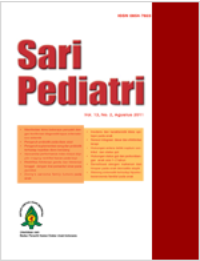Kualitas Hidup Anak Epilepsi dan Faktor–Faktor yang Mempengaruhi di Departemen Ilmu Kesehatan Anak FKUI/RSCM Jakarta
Sari
Latar belakang. Epilepsi merupakan penyakit kronik yang dapat mempengaruhi kualitas hidup anak di masa depan. Saat ini penelitian untuk menilai kualitas hidup anak epilepsi masih terbatas.
Tujuan. Melakukan penilaian faktor-faktor klinis, demografi, psikososial dan obat anti epilepsi (OAE) yang mempengaruhi kualitas hidup anak epilepsi dengan menggunakan instrumen Quality of life in childhood epilepsy questionnaire-parent form (QOLCE).
Metode. Penelitian dilaksanakan di Poliklinik Neurologi Departemen Ilmu Kesehatan Anak FKUI-RSCM dalam kurun waktu Desember 2007 sampai April 2008. Terkumpul 68 orang responden yang memenuhi kriteria inklusi dengan melakukan wawancara secara langsung oleh peneliti.
Hasil. Jumlah serangan kejang dalam 6 bulan terakhir (faktor klinis), usia anak dan jumlah anak dalam keluarga (faktor demografi), kecemasan orang tua (faktor psikososial) mempengaruhi kualitas hidup anak epilepsi. Jumlah obat anti epilepsi (OAE) berkorelasi dengan komponen restriksi fisik pada fungsi fisik yaitu semakin sedikit jumlah OAE semakin tidak dibatasi aktivitas fisiknya.
Kesimpulan. Kualitas hidup anak epilepsi dipengaruhi oleh jumlah serangan kejang dalam 6 bulan terakhir, usia anak, jumlah anak dalam keluarga, kecemasan orang tua, dan jumlah OAE. Pengenalan dini terhadap gangguan kualitas hidup pada anak epilepsi dapat memperbaiki kualitas hidup di masa depan.
Kata Kunci
Teks Lengkap:
PDFReferensi
Eiser C, Morse R. A review of measures of quality of life for children with chronic illness. Arch Dis Child 2001;84:205-11.
Panaylotopoulus. Clinical aspects of the diagnosis of epileptic seizures and epileptic syndromes. The epilepsies: seizures, syndromes and management. Bladon Med Publ;2005.h.1-28.
Bellman A, Nappa A, Soot A, Talvik I, Talvik T. Prevalence of childhood epilepsy in Estonia. Epilepsia 1999;40:1011-9.
Sidenvall R. Forsgren L, Heijbel J. Prevalence and characteristics of epilepsy in children in Northern Sweden. Seizure 1996;5:139-46.
Sridharan R, Murthy BN. Prevalence and pattern of epilepsy in India. Epilepsia 1999;40:631-6.
Radhakrisnan K, Pandian JD, Santhoskumar SV, Deetha TD, Sarma PS, Jayachandran, dkk. Prevalence, knowledge, attitude and practice of epilepsy in Kerala South India. Epilepsia 2000;41:1027-35.
Data rekam medik Departemen Ilmu Kesehatan Anak FKUI/RSCM, 2008.
Wall M, Buchanan N, Baird-Lambert J. The management of epilepsy: patient’s perceptions and expectation. Med J Aust 1987;146:473-6.
Malhi P, Singhi P. Correlates of quality of live with epilepsy. Indian J Pediatr 2005;72:131-5.
Williams J, Steel C, Sharp GB, DelosReyes E, Philips T, Bates S. Parental anxiety and quality of life in children with epilepsy. Epilepsy Behav 2003;4:483-6.
Mitchell WG, Scheier LM, Baker SA. Psychosocial, behavorial, and medical outcomes in children with epilepsy: a developmental risk factor model using longitudinal data. Pediatrics 1994;94:471-7.
Yong L, Chengye J, Jiong Q. Factor affecting the quality of life in childhood epilepsy in China. Acta Neurol Scand 2006;113:167-73.
Sillanpaa N, Jalava M, Kaleva O, Shinnar S. Long-term prognosis of seizure with onset in childhood. N Engl J Med 1998;338:1715-22.
Loring DW, Meador KJ. Cognitive and behavorial effects of epilepsy treatment. Epilepsia 2001;42:24-32.
Meador KJ, Baker GA. Behavorial and cognitive effecs of lamotrigine. J Child Neurol 1997;12:544-7.
Gerber PE, Pharm D, Hamiwka K, Connoly MB, Farrell K. Factor associated with behavorial and cognitive abnormalities in children receiving topiramate. Elsevier Science 2000;22:200-3.
Djibuti M, Shakarishvili R. Influence of clinical, demographic, and socioeconomic variables on quality of life in patients with epilepsy: finding from Georgian study. J Neurol Neurosurg Psy 2003;74:570-3.
Meador KJ. Cognitive effects of epilepsy and of antiepileptic medications. Dalam: Wyllie E, Mitchell CW, Keating MK, penyunting. The treatment of epilepsy: principles and practice. Edisi ke-2. Philadelphia: Lippincott Williams & Wilkins;1996. h.1121-30.
Rodenburg R, Stams GJ, Meijer AM, Aldenkamp AP, Dekovic M. Psychopatology in children with epilepsy: a meta-analysis. J Pediatr Psy 2005;30:453-68.
Sabaz M, Cairns DR, Lawson JA, Nheu N, Bleasel AF, Bye AME. Validation of new quality of life measure for children with epilepsy. Epilepsia 2000;41:765-74.
Lim K, Kang HC, Kim HD. Validation of a Korean version of the quality of life in childhood epilepsy questionnaire (K-QOLCE). J Korean Epilepsy Soc 2002;6:32-44.
Sabaz M, Lawson JA, Cairns DR, Duchowny MS, Resnick TJ, Dean PM, dkk. Validation of quality of life in childhood questionnaire in American epilepsy patient. Epilepsy Behav 2003;4:680-91.
Osamal A, Tantawy A. Quality of life in childhood epilepsy. Diunduh dari: http://www.esnpn.org/joun/38-2/17.htm. Diakses tanggal 5 Januari 2007
Talarska D. The usefulness of quality of life childhood epilepsy (QOLCE) questionnaire in evaluating the quality of life of children with epilepsy. Advance Med Science 2007;52 (suppl 1):191-3.
Mathiak KA, Karzel K, Mathiak K, Ostaszewski P, Tuba M, Wolanczyk T. Polish adaptation and validation of health-related quality of life in childhood epilepsy questionnaire. Neurologia i Neurochirurgia Polska 2007;41:203-14.
Handryastuti S, Pusponegoro HD, Mangunatmadja I. Quality of life of children with epilepsy. Disampaikan dalam KONIKA XII 2002, Bali.
Soedjatmiko. Skrining gangguan perkembangan perilaku anak dengan pediatric symptom checklist. Tridjaja B, Trihono P, Irfan EB, penyunting. Pediatrics Update 2005. Disampaikan dalam PKB II IDAI JAYA 2005, Jakarta 2005.h.53-8.
Snaith P, Baugh J, Clayden AD, Husain A, Sipple MA. The clinical anxiety scale: an instrument derived from the Hamilton anxiety scale. Brit J Psychiat 1982;141:518-23
Psychatric Associate of Atlanta. Hamilton anxiety scale (HAM-A). Diunduh dari : http://www.atlantapsychiatri.com. Diakses tanggal 13 Agustus 2007.
Anonim. Indikator operasional kemiskinan: situs resmi badan koordinasi keluarga berencana nasional (BKKBN). Diunduh dari: http://www.bkkbn.go.id/ dki_jakarta/administrator/artikel/indik_miskin.htm. Diakses tanggal 20 Maret 2007.
DOI: http://dx.doi.org/10.14238/sp10.4.2008.272-9
Refbacks
- Saat ini tidak ada refbacks.
##submission.copyrightStatement##
##submission.license.cc.by-nc-sa4.footer##
Email: editorial [at] saripediatri.org


Sari Pediatri diterbitkan oleh Badan Penerbit Ikatan Dokter Anak Indonesia
Ciptaan disebarluaskan di bawah Lisensi Creative Commons Atribusi-NonKomersial-BerbagiSerupa 4.0 Internasional.




